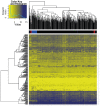The glycome of normal and malignant plasma cells
- PMID: 24386263
- PMCID: PMC3873332
- DOI: 10.1371/journal.pone.0083719
The glycome of normal and malignant plasma cells
Abstract
The glycome, i.e. the cellular repertoire of glycan structures, contributes to important functions such as adhesion and intercellular communication. Enzymes regulating cellular glycosylation processes are related to the pathogenesis of cancer including multiple myeloma. Here we analyze the transcriptional differences in the glycome of normal (n = 10) and two cohorts of 332 and 345 malignant plasma-cell samples, association with known multiple myeloma subentities as defined by presence of chromosomal aberrations, potential therapeutic targets, and its prognostic impact. We found i) malignant vs. normal plasma cells to show a characteristic glycome-signature. They can ii) be delineated by a lasso-based predictor from normal plasma cells based on this signature. iii) Cytogenetic aberrations lead to distinct glycan-gene expression patterns for t(11;14), t(4;14), hyperdiploidy, 1q21-gain and deletion of 13q14. iv) A 38-gene glycome-signature significantly delineates patients with adverse survival in two independent cohorts of 545 patients treated with high-dose melphalan and autologous stem cell transplantation. v) As single gene, expression of the phosphatidyl-inositol-glycan protein M as part of the targetable glycosyl-phosphatidyl-inositol-anchor-biosynthesis pathway is associated with adverse survival. The prognostically relevant glycome deviation in malignant cells invites novel strategies of therapy for multiple myeloma.
Conflict of interest statement
Figures








References
-
- Kyle RA, Rajkumar SV (2004) Multiple myeloma. N Engl J Med 351: 1860–1873. - PubMed
-
- Cremer FW, Bila J, Buck I, Kartal M, Hose D, et al. (2005) Delineation of distinct subgroups of multiple myeloma and a model for clonal evolution based on interphase cytogenetics. Genes Chromosomes Cancer 44: 194–203. - PubMed
-
- Fonseca R, Barlogie B, Bataille R, Bastard C, Bergsagel PL, et al. (2004) Genetics and cytogenetics of multiple myeloma: a workshop report. Cancer Res 64: 1546–1558. - PubMed
-
- Barlogie B, Tricot GJ, van Rhee F, Angtuaco E, Walker R, et al. (2006) Long-term outcome results of the first tandem autotransplant trial for multiple myeloma. Br J Haematol 135: 158–164. - PubMed
-
- Harousseau JL, Moreau P (2009) Autologous hematopoietic stem-cell transplantation for multiple myeloma. N Engl J Med 360: 2645–2654. - PubMed
Publication types
MeSH terms
Substances
LinkOut - more resources
Full Text Sources
Other Literature Sources
Medical
Research Materials

